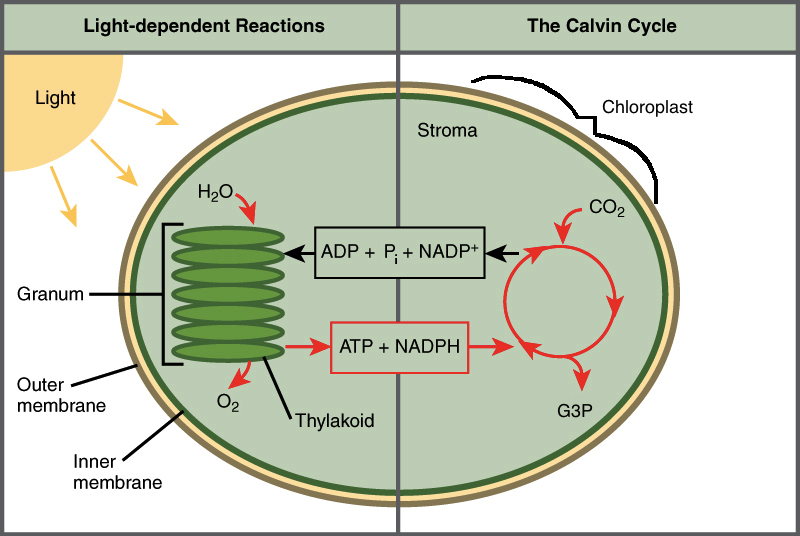The Fascinating World of Photosynthesis: Life’s Green Engine Link to heading
Imagine a world without plants. No trees, no flowers, no grass – just barren landscapes. It’s a grim picture, isn’t it? Yet, the vibrant world we live in owes much of its existence to a single, fundamental process: photosynthesis. This miraculous process allows plants to convert sunlight into the energy they need to grow, and in turn, provides the oxygen we breathe. Let’s dive into the verdant depths of photosynthesis and uncover the secrets of this life-sustaining phenomenon.
The Basics of Photosynthesis Link to heading
At its core, photosynthesis is the process by which green plants, algae, and some bacteria convert light energy into chemical energy. This takes place in the chloroplasts within plant cells, using the green pigment chlorophyll. The overall chemical equation for photosynthesis can be summarized as:
6 CO2 + 6 H2O + light energy → C6H12O6 + 6 O2
Or, in simpler terms:
Carbon dioxide + water + light energy → glucose + oxygen
The Two Stages of Photosynthesis Link to heading
Photosynthesis occurs in two main stages: the light-dependent reactions and the Calvin cycle (or light-independent reactions).
-
Light-dependent Reactions: These reactions take place in the thylakoid membranes of the chloroplasts. Here, chlorophyll absorbs light energy, which excites electrons and initiates the splitting of water molecules into oxygen, protons, and electrons. The energy harnessed is used to produce ATP and NADPH, molecules that store energy for the next stage.
-
Calvin Cycle: This cycle occurs in the stroma of the chloroplasts, where ATP and NADPH produced in the light-dependent reactions are used to convert carbon dioxide into glucose through a series of enzyme-driven steps. The glucose can then be used by the plant for energy or stored for later use.
The Importance of Photosynthesis Link to heading
Photosynthesis is not just a process that sustains plants; it is the foundation of life on Earth as we know it. Here’s why:
Oxygen Production Link to heading
Photosynthesis is responsible for producing the majority of the oxygen in our atmosphere. Without it, aerobic organisms, including humans, would not have the oxygen required for respiration. Historical records indicate that around 2.4 billion years ago, the Great Oxygenation Event transformed Earth’s atmosphere, paving the way for the evolution of complex life (Lyons et al., 2014).
Carbon Dioxide Regulation Link to heading
Plants absorb carbon dioxide during photosynthesis, helping to regulate atmospheric CO2 levels. This plays a crucial role in mitigating climate change. Forests and other vegetation act as carbon sinks, sequestering carbon and reducing the greenhouse effect.
Food Production Link to heading
Photosynthesis is the initial step in the food chain. Plants produce glucose through photosynthesis, which serves as the primary energy source for herbivores. In turn, herbivores become food for carnivores. This energy transfer across trophic levels sustains ecosystems worldwide.

Photosynthesis in Action: The Chloroplast Link to heading
The chloroplast is the photosynthesis powerhouse. Within its double-membraned structure, the thylakoid membranes house the light-dependent reactions, and the surrounding stroma hosts the Calvin cycle. The chloroplast’s efficiency is a marvel of natural engineering, optimizing light capture and energy conversion.
Chlorophyll: The Green Magician Link to heading
Chlorophyll is the pigment responsible for the green color of plants. It’s incredibly efficient at capturing light, particularly in the blue and red wavelengths. This pigment’s ability to absorb and transfer light energy is at the heart of photosynthesis.
A Witty Reflection: Photosynthesis and Solar Panels Link to heading
In a way, plants are nature’s solar panels. They capture sunlight and convert it into usable energy with remarkable efficiency. While our solar technology continues to advance, it’s humbling to realize that plants have been perfecting this process for over 3 billion years. Maybe we should take a leaf out of their book – pun intended.
The Stoic Truth: The Balance of Life Link to heading
Photosynthesis exemplifies the delicate balance of life. It’s a reminder of the interconnectedness of all living things and our reliance on nature’s processes. As we face environmental challenges, understanding and preserving photosynthesis is paramount to sustaining life on our planet.
Closing Thoughts Link to heading
Photosynthesis is more than just a biological process; it’s a testament to the ingenuity of nature. From providing the oxygen we breathe to sustaining the food chains that nourish us, photosynthesis is truly life’s green engine. Next time you see a leaf, take a moment to appreciate the incredible machinery within it, working tirelessly to sustain life on Earth.
References Link to heading
Lyons, T. W., Reinhard, C. T., & Planavsky, N. J. (2014). The rise of oxygen in Earth’s early ocean and atmosphere. Nature, 506(7488), 307-315. doi:10.1038/nature13068
This post was inspired by the incredible complexity and simplicity of photosynthesis. We hope you found it as fascinating as we do!